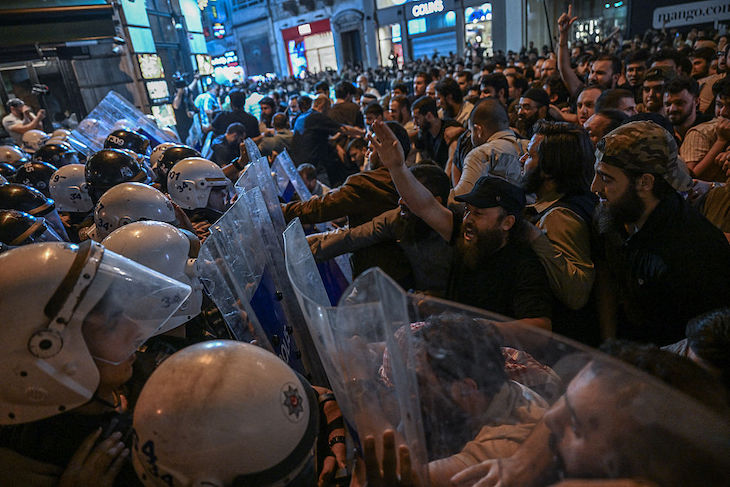Journalists at LeMan are in fear for their lives after the Turkish satirical magazine published cartoons appearing to depict the Prophet Muhammad. The publication’s editor-in-chief Tuncay Akgun denied that the picture showed Muhammad, but his pleas have fallen on deaf ears. A mob gathered outside the magazine’s office in Istanbul on Monday. In the days since, Turkish president Recep Tayyip Erdogan has slammed the cartoon as a ‘vile provocation’, and Foreign Minister Hakan Fidan described the image as an ‘immoral…attack against our Prophet’. But LeMan‘s critics appear to be blind to Islam’s rich tradition of depicting Muhammad.
The idea of a categorical ban on drawings of Muhammad appears to be grounded in the Salafi strain of Islam
Much of the backlash over these apparent depictions of Muhammad is rooted in the belief that Islam declares any imagery of him haram, or forbidden; this view seems to be supported by a few hadiths, or sayings of Muhammad, which suggest that because drawings ‘create life’ they trespass on what Muslims perceive to be Allah’s prerogative. But the sweeping assertion banning Muhammad’s depiction, often reported as fact in Western media, upholds the most regressive interpretation of the religion as the sole representation of the Muslim faith. It is important to push back against this.
For centuries, Muslims have depicted Muhammad. Eleventh-century Persian epics like Varka and Golshah and Abu Rayhan Al-Biruni’s The Remaining Signs of Past Centuries feature some of the earliest illustrations of Muhammad during significant stages of his prophethood, including him narrating and explaining Quranic verses.
The Mojmal al-Tawarikh, or Compendium of Histories, highlighting the history of Persian kings, also showcase numerous images of Muhammad, including him receiving revelations from the angel Jibraeel. A frequently illustrated image is of the Mi’raj, the Islamic tale of Muhammad’s ascension to heaven on a winged horse as part of his journey to Al-Aqsa mosque, the event that asserts the Islamic claim over Jerusalem.
The idea of a categorical ban on drawings of Muhammad appears to be grounded in the Salafi strain of Islam, which, in recent decades, has been proliferated by Sunni Arab monarchies as part of their bid to assert control over the Muslim world. But while many of the depictions of Muhammad can be found in Shia Islam, there are numerous examples among Sunni practitioners as well – especially the Sufi interpretations such as the Siyer-i-Nebi, an epic on Muhammad’s life published around 1388. Nowadays, such images are rarely mentioned – not least in the West, where those who dare depict Muhammad soon find themselves in trouble. In 2022, for instance, The Lady of Heaven film, which featured Muhammad’s daughter Fatimah, resulted in a ‘blasphemy’ backlash. The movie was subsequently pulled from cinemas in various countries, including in the UK.
Violent backlashes over cartoons of Muhammad have been witnessed the world over, as seen in the aftermath of Danish newspaper Jyllands-Posten’s publication of satirical sketches of the prophet of Islam in 2005, which resulted in around 150 deaths and attacks on European embassies. Eight Charlie Hebdo journalists were among 12 killed in a jihadist shooting on the French satirical magazine in 2015 over Muhammad caricatures. Showing students cartoons of the Prophet Muhammad resulted in French teacher Samuel Paty being decapitated in 2020. When a teacher at Batley Grammar School in West Yorkshire did the same, he was forced into hiding. He now lives under a new identity.
Such incidents have made publications extremely wary of depicting Muhammad. But what makes the ongoing cartoon row in Turkey all the more absurd is the long and rich tradition of drawing Muhammad in Ottoman history. Erdogan appears to be on a quest to replicate a neo-Ottoman empire, but this is one area of Ottoman history he seems rather less keen to emulate.
LeMan’s cartoon does not satirise or mock Muhammad; it illustrates Moses and Muhammad shaking hands in the sky while there is war and destruction in the background. Regardless of whether the Muhammad in question was Islam’s prophet – or a representation of Muslims with the most common masculine first name, as the magazine insisted – the message upheld peace between the Jewish and Muslim communities amidst the conflicts in the Middle East.
The mob, unsurprisingly, appears blind to this interpretation – so, too, does Erdogan. Instead, his government has resorted to more typical Islamist intimidation tactics against a magazine that has been critical of it. It is a move designed to silence dissenters.
In Turkey, the Kemalist left has already surrendered significant space to Erdogan, endorsing Islamic modesty codes such as the hijab in stark contradiction of traditional, secular laiklik values of the Turkish republic. This row – and the capitulation to the Islamists – clearly shows the direction of travel in Turkey. Turkey has now effectively joined the list of Muslim countries that have adopted blasphemy laws.






Comments